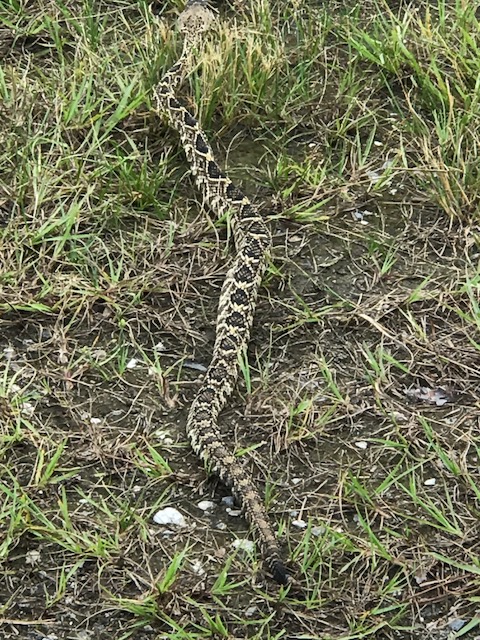
by Rick O'Connor | Dec 29, 2025
All animals have a thermal range within which they can survive. For some it is very small range, for others it is amazingly large. Whatever their range is, they function best near the upper portion of it. “Warm blooded” animals (endotherms) have high metabolisms and generate warmth internally. Most have covering over their skin, fur or feathers, that assist with insulating them. “Cold blooded” animals (ectotherms) are the opposite. They have lower metabolisms, generate less internal heat, and most have covering over their skin (scales) that do not provide sufficient insulation. Thus, ectotherms must bask in the sun to get their body temperatures up to peak functioning levels. They will also hide in the shade or water to cool down. Rattlesnakes are ectotherms.

Eastern diamondback rattlesnake crawling near Ft. Pickens Campground.
Photo: Shelley Johnson
Generally, the coldest part of the day is just before dawn. If a snake was hunting at night, and many species do, they will venture out in the morning to find a sunny spot to warm up so they can complete the digestive process. They do need sun, but they need to avoid open spaces where predators can find them. Often, they will select spots near the edge of a wooded area, or edge of rocky outcrop, so they can dash in if trouble arrives. Snakes have been known to stretch out on roads where the pavement has been heated during the day. Unfortunately, many are hit by vehicles while doing this. As the day warms up, they will move into cooler spaces to avoid overheating. Rattlesnakes are more active, and prefer to hunt during the daylight hours, though evening movements do occur.
There are seasonal behavior changes to deal with thermoregulation. During winter, in regions where it gets cold (maybe even snows), rattlesnakes will hibernate. Hibernation involves gorging on food in the fall to store fat to feed off during the hibernation period. Next, they will find a good hiding spot – a rocky den, a cave, gopher tortoise burrow, hole beneath a tree stump – where they will be safe from predation until spring. Once in this hibernaculum, they will lower their breathing and heart rate and allow their body temperature to drop. They go into a state of torpor where they are basically shut down. Many rattlesnakes use the same hibernacula each year, finding it by their sense of smell. Some species will share this space with several others – literally a den of snakes.
In the spring, when the air temperatures reach 70°F, they will emerge and immediately seek food. In some locations the summers will become very hot and so feeding and reproduction are on their minds before it becomes too hot, and they have to hide again. It is during these feeding/mating forays that many people encounter them. During this period they may move during periods of the day, and into locations they might avoid otherwise.
If they live in locations where summer can be very hot, they will repeat this behavior to avoid overheating – this is called aestivation. Another problem with hot summers is dehydration. Aestivation is more spontaneous than hibernation.
The eastern diamondback rattlesnake, the one often found on our barrier islands, lives only in the warmer parts of the southeastern U.S. It does get cold in some parts of their range, but they are not common where it snows. However, it does get very hot where they live and so even though hibernation is part of their life cycle, aestivation is common.
Next, we will look at reproduction.
References
Rubio, M. 2010. Rattlesnakes of the United States and Canada. ECO Herpetological Publishing & Distribution. Rodeo, New Mexico. pp. 307.
Gibbons, W., Dorcas, M. 2005. Snakes of the Southeast. The University of Georgia Press. Athens, Georgia. pp. 253.
Graham, S.P. 2018. American Snakes. John’s Hopkins University Press. Baltimore, Maryland. pp. 293.
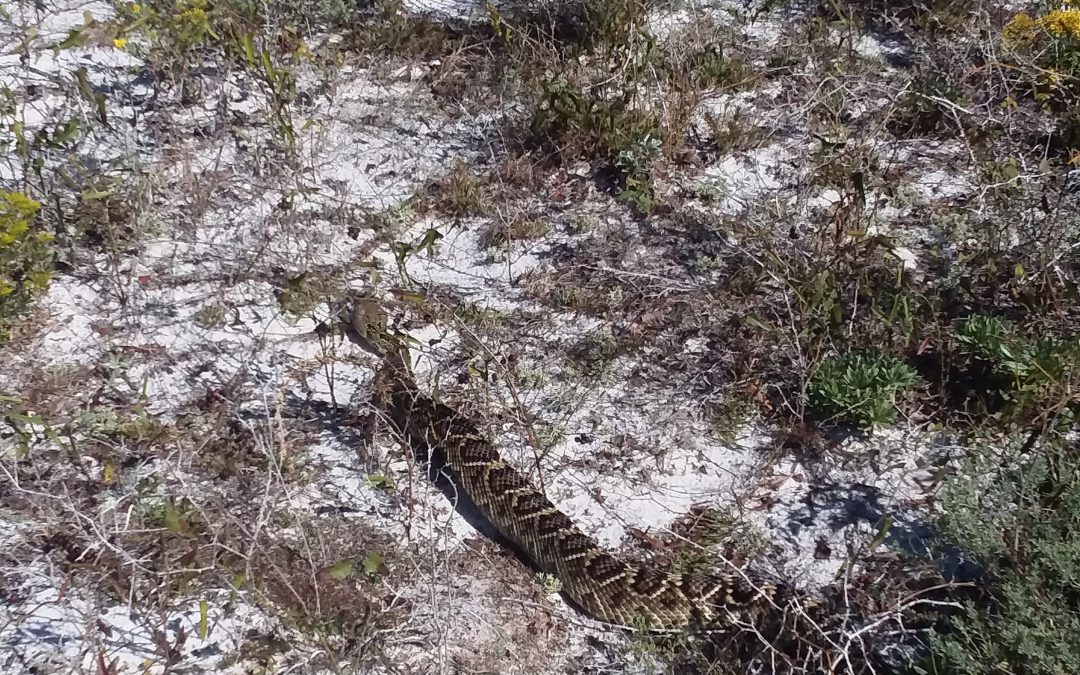
by Rick O'Connor | Dec 22, 2025
Though encounters with Eastern Diamondback Rattlesnakes are rare, bites from them are even more rare, and deaths from those bites almost nonexistent, it is worth discussing the issues and remedies of a bite.

The eastern diamondback rattlesnake is a classic serpent found in xeric habitats like barrier islands and deserts. They can be found in all habitats on barrier islands.
Photo: Bob Pitts
About 8000 people are bitten by snakes each year in the U.S. and Canada. Most are on the hands of men who were engaging the snake. 95% of those bitten are trying to either catch or kill them. Annually less than 12 people die from some species of rattlesnake bite. Many are young or old, with a suppressed immune system or pre-existing medical condition. Many who die, for whatever reason, refused medical treatment.
Most lethal bites are those that reach the heart or brain. However most bites are on the extremities where tissue and nerve damage can occur, but death is less likely. One reason some may refuse medical treatment is cost. Antivenin treatments are expensive. Typical bites may require 4-6 vials and costs were between $1500-$3500/vial in 2010. Add to this the cost of hospital stays, and you can see how expensive it can be.
Another reason given as to why medical attention was not sought is the fact that many venomous snakes will give what is called a “dry bite”. As mentioned in earlier articles, snake venom is “expensive” for snakes to produce, and it is intended for prey – not predators. Rattlesnakes will often give what is called a “bluff bite” – striking with their head but not even opening their mouths. The injection of venom is a voluntary action by the snake, and they may choose to inject very little, if any, venom even if the fangs penetrate. It is believed that about 50% of the rattlesnakes are dry bites. That said, you should never gamble on whether you received venom or not, you should go to the hospital.
The venom itself is a cocktail of proteins, polypeptides, digestive enzymes, and other compounds. It is basically modified salvia – which already includes some digestive enzymes. Myotoxins are a large component of rattlesnake venom. Myotoxins attack muscle tissue, cause pain, discoloration, minor bleeding, and swelling. This can be accompanied by chills, sweats, dizziness, disorientation, tingling and numbness of mouth and tongue, metallic taste, vomiting, diarrhea, bloody stools, alternating blood pressure and heart rates, blurred vision, muscle spasms, and neurotoxins can paralyze diaphragm leading to asphyxiation.
To avoid envenomation problems wear closed-toed shoes when hiking in rattlesnake territory. Do not extend your hand into brushy/grassy areas – use your hiking stick instead. Watch stepping over, or sitting on, logs and stumps without close surveying. Do not touch dead rattlesnakes, if not dead long, they can still bite. Carry a cell phone.
What to do if bitten…
Call 911.
Call poison control if you have their number.
Get to a hospital.
Remove rings, watches, etc. – swelling will occur.
Keep bite at, or below, heart level.
Remain calm.
What NOT to do if bitten…
Do not cut the wound.
Do not suck venom out.
Do not apply a tourniquet.
Do not apply ice.
Do not drink alcohol.
Do not use electroshock treatment.
Envenomation from an eastern diamondback rattlesnake is a scary thing. However, there are many ways to avoid this problem, and there is basic treatment if you are. Remember few people are bitten, and very few die. Get medical attention as soon as you can.
References
Rubio, M. 2010. Rattlesnakes of the United States and Canada. ECO Herpetological Publishing & Distribution. Rodeo, New Mexico. pp. 307.
Gibbons, W., Dorcas, M. 2005. Snakes of the Southeast. The University of Georgia Press. Athens, Georgia. pp. 253.
Graham, S.P. 2018. American Snakes. John’s Hopkins University Press. Baltimore, Maryland. pp. 293.
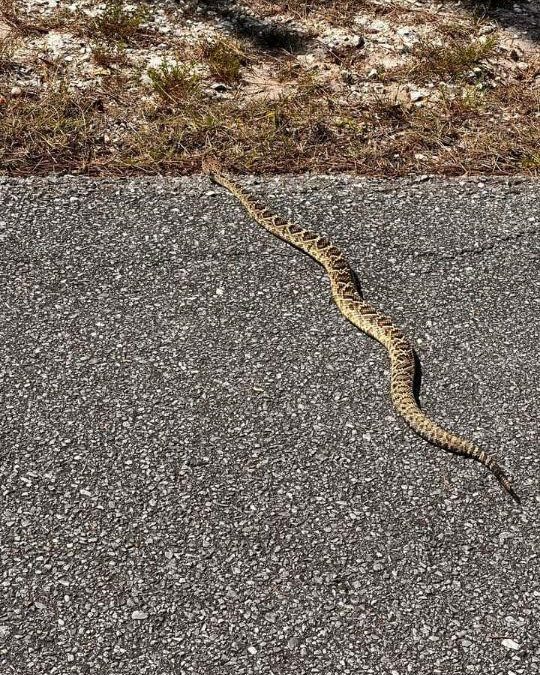
by Rick O'Connor | Dec 15, 2025
It is understood that rattlesnakes are carnivores and will select some form of meat for their food. The general principle is to select something that is easy to kill and requires less energy to do so. Most rattlesnakes will select rodents but depending on the species and the part of the world they are in, some will select lizards or other prey.
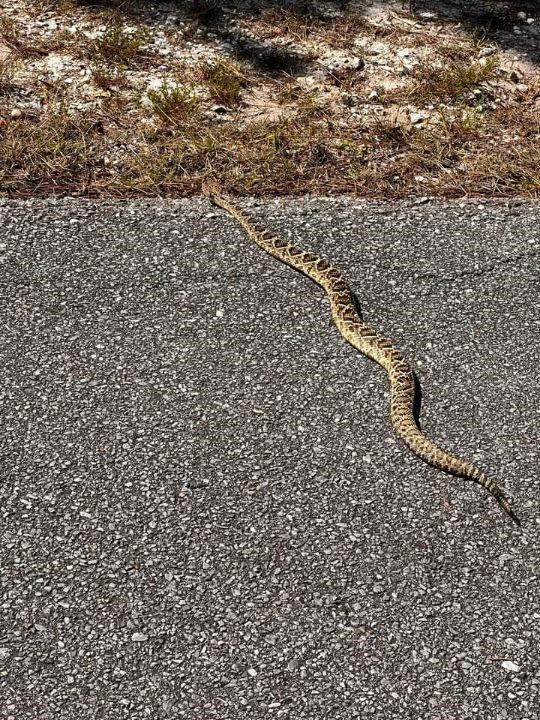
Eastern Diamondback Rattlesnake.
Photo: Bob Pitts.
Due to their long periods of hibernation and/or aestivation, their feeding seasons are shortened. If you add low prey availability when they emerge from hiding, the feeding season is shorter still. They respond by binge eating – basically gorging on prey as often as they can. They may consume massive meals that will take over a week to digest.
Rattlesnakes who feed on rodents over lizards will grow larger. Many species have young with bright pink or yellow tips on their tails, much like cottonmouths and copperheads. These are used to lure small prey such as lizards and toads. They are predominantly ambush hunters, lying in wait for selected prey to wander into striking range. They like spots where they are half in the shade, half in the sun to do this.
Here is a scenario…
In the spring, when the temperature reaches 70°F, rattlesnakes will leave the hibernacula they used for hibernation. Having not eaten in a while, food is on their mind. They will use their sense of smell to find the trails of their potential prey, find a good ambush spot, and wait. Some studies suggest they sleep while waiting. They may first detect their prey by seeing it. It could be by hearing or smelling. Or by a combination of these. They will begin to flick their tongues – using the Jacobsen’s organ – to further identify the target. When within range, the facial pits can help “see” the target and assist in accuracy of their strike.
The strike is extremely fast. The snake injects their venom, releases, re-coils, and folds their fangs back into their sheath. The target often will run but is usually dead within a minute and not far away. The rattlesnake will now find the scent trail with their tongue and follow its meal. It can take several minutes to an hour to find it. Once found the prey is dead and already in the process of digestion due to some of the enzymes within their venom. In some prey the rattlesnake may not release and rather hold on to the prey after the bite. This often happens when they select birds, possibly due to the difficulty of finding them because they may fly before they die. Another interesting twist to this scenario holds for the timber rattlesnakes, who sometimes lie at the base of a tree with their heads facing up the trunk waiting on an unaware squirrel coming down.
Swallowing the prey involves “unhinging” their lower jaw making the diameter of their mouths larger. This way rattlesnakes can swallow large prey such as squirrels and rabbits. They have six rows of smaller pointed teeth in their mouths. There are two rows on the lower jaw, two on the upper, and two on the roof of their mouths. With the fangs folded back in their sheath, they begin to grab the prey with one set of jaws (the right or left) pull in, then alternate with the other jaw. It appears they are “walking the prey down” their throat. There is a tube called the glottis on the forward portion of the lower mouth that is used for breathing while their mouth is full. They have been seen taking breaks and resting while this process is ongoing. After swallowing, they re-align their lower jaw and find a place to rest and digest the meal.
Being ectothermic they will need to find warmth to digest their meal. They require internal temperatures between 80-85°F for proper digestion, so, they will need to find a location where there is good sunlight but enough cover to hide them. Depending on the size of the meal, digestion can last up to a week.
This scenario can be altered if prey density is low. If it is, rattlesnakes may move, and forage more than they typically do. As you can see, an approaching human during any part of this scenario would be unwanted by the snake.
In the next article we will take a closer look at the venom of these snakes.
References
Rubio, M. 2010. Rattlesnakes of the United States and Canada. ECO Herpetological Publishing & Distribution. Rodeo, New Mexico. pp. 307.
Gibbons, W., Dorcas, M. 2005. Snakes of the Southeast. The University of Georgia Press. Athens, Georgia. pp. 253.
Graham, S.P. 2018. American Snakes. John’s Hopkins University Press. Baltimore, Maryland. pp. 293.
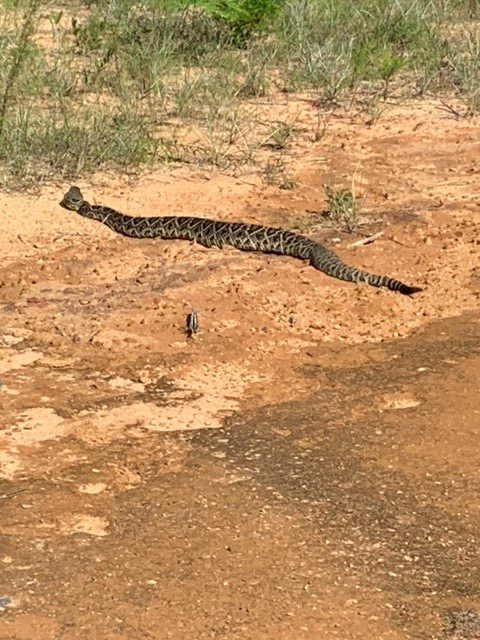
by Rick O'Connor | Dec 8, 2025
We will begin with a statement most know, but bears repeating… Snakes are just another animal trying to get through the day. They need to eat, avoid being eaten, find a place to sleep, and – at some point in the year – find a mate. They are no different than raccoons or hawks. But our reactions to these animals are very different to our reaction to raccoons and hawks. When hiking in the woods when someone says “bald eagle” the reaction is uplifting, maybe get a photo. But if someone says “snake” the reaction is different. If they say “rattlesnake” that reaction increases several magnitudes. In Manny Rubio’s book on rattlesnakes, he mentions that 50% of our population is “uneasy” about them and 20% are terrified of them – ophidiophobia is a real thing. That said, rattlesnakes are part of the barrier island ecology, and it is good to learn more about them.

This eastern diamondback rattlesnake was seen crossing a dirt road near DeFuniak Springs shortly after the humidity dropped.
Photo: Lauren McNally
Rattlesnakes are only found in the new world. There are 30 species listed in the U.S. and Canada and three of those live in Florida. One of them, the eastern diamondback rattlesnake, lives on our barrier islands. The pygmy rattlesnake may as well, but I have not encountered it (nor have heard of others encountering). The canebrake/timber rattlesnake is not common in Florida, and I have never heard of them on our islands.
These snakes differ from others in that they possess modified scales at the tip of their blunt tails we call rattles. Many snakes vibrate their tails when alarmed but this snake’s vibrations can be heard at a distance (up to 20-30 feet sometimes) to warn potential predators they are there. Each time the snake sheds its skin it will leave a new segment on the rattle. This is not a good way to age the snake however because they may shed several times in one year and older segments can break off. There have been reports of rattlesnakes with deformed tails and no rattles at all, but this is rare.
They also possess facial pits that have cells which can detect temperature radiating from an object, including “warm blooded” prey, while hiding. These thermal receptors lie along the bottom of the facial pit and are connected to the optic nerve; thus, they can sort of “see” heat.
Their eyesight is not as good as birds and mammals, and they have an elliptical pupil. They appear to use their eyesight in determining the size of the approaching animal and thus, their reaction to it.
They have nostrils but smell does not seem to play as important a role as Jacobsen’s organ does. This organ is found on the roof of their mouths. Rattlesnakes (all snakes) will flick their forked tongues to collect air molecules and stick the tip of each fork into a groove in the roof of their mouths that lead to this organ. Here they can taste/smell what is within their environment. The “taste” of potential prey will increase the frequency of tongue flicks and could cause the snake to move forward.
The fangs are the part of this animal we are most concerned about. They are hollow tubes connected to a venom gland which are located behind each jaw and give the snake the triangular head shape they are known for. These fangs are folded in a sheath so that they can close their mouths. Whether only one or both fangs are extended during a bite is controlled by the snake. Fangs often break off but smaller new ones are ready to replace them when needed. They will replace these fangs every two months, one at a time.
The strike involves opening the mouth, extending the fangs 90°, opening the mouth 180°, thrusting forward, bite down, inject, recoil, re-fold fangs, and back into the attack position. There are “offensive” and “defensive” strikes. Venom is “expensive” for snakes to produce and is meant for killing prey. The amount injected (if any at all) is controlled by the snake. A “defense” strike is slightly elevated. The upward angle reduces thrust and penetration depth.
Other general characteristics of rattlesnakes includes a triangular shaped head, most have a dark “mask” over their eyes, scales protruding over the eyes, keeled scales giving them a dry/rough appearance, and the males have longer tails than the females.
In our next post we will look at rattlesnake predation.
References
Rubio, M. 2010. Rattlesnakes of the United States and Canada. ECO Herpetological Publishing & Distribution. Rodeo, New Mexico. pp. 307.
Gibbons, W., Dorcas, M. 2005. Snakes of the Southeast. The University of Georgia Press. Athens, Georgia. pp. 253.
Graham, S.P. 2018. American Snakes. John’s Hopkins University Press. Baltimore, Maryland. pp. 293.

by Rick O'Connor | Nov 10, 2025
Over the last decade human-bear encounters have increased across Florida, including the Panhandle. Recently the Florida Fish and Wildlife Conservation Commission (FWC) posted advice on how we can prepare for the fall season.

Florida Black Bear visiting an easy food source.
They mention that fall is a time when bears begin seeking additional food sources to prepare for winter. An adult bear can consume up to 20,000 calories a day during this prep period. All creatures will seek the easiest source of food, reducing energy effort in capturing, and will take the opportunity to raid garbage cans, pet food left outside, and even bird feeders. Here are tips FWC suggests.
- Never Feed Bears. Doing so will reduce their natural fear of humans, and intentionally doing so is illegal in Florida.
- Secure Food and Garbage. Some suggestions on how to do this…
- Keep your trash can in a sturdy shed or garage and do not place on the street until morning.
- Modify your trash can to make it more secure. Tips for this can be found from FWC at Instructions on Making a Trashcan Bear-Resistant.
- Purchase a bear resistant trash can. Bear Resistant Trash Containers.
- They are attracted to gardens, compost piles, beehives, and livestock. Take measures to reduce their ability to reach these.
- Pick ripe from fruit trees and remove fallen fruit from the ground.
- Remove, or secure, bird feeders. If you want to feed winter birds, place only enough food for the delay and remove it at night. You can find other suggestions to help winter birds at this site – Attract Backyard Birds, Not Backyard Bears – BearWise.
- Never leave pet food outdoors. This is actually a good suggestion to reduce raccoon, coyote, and other wildlife encounters. If you must feed your pet outside, do so for only short periods and bring all food after dark.
- Clean and store grills.
- Alert neighbors to bear activities. Share these tips with them and your HOA.
Bears are generally afraid of humans and are not aggressive but can become so when there are mothers protecting cubs, and dogs. 60% of all human-bear encounters involved dogs. When walking your dogs keep them on a short leash and be aware of your surroundings and your dog’s reaction to your surroundings. Before letting your dog out at night turn the exterior lights on and off several times and bang the door. Keep in mind they will be moving more this time of year and are most often encountered on the roads at dawn and dusk.
If you have further questions, or need further information, search the FWC website.
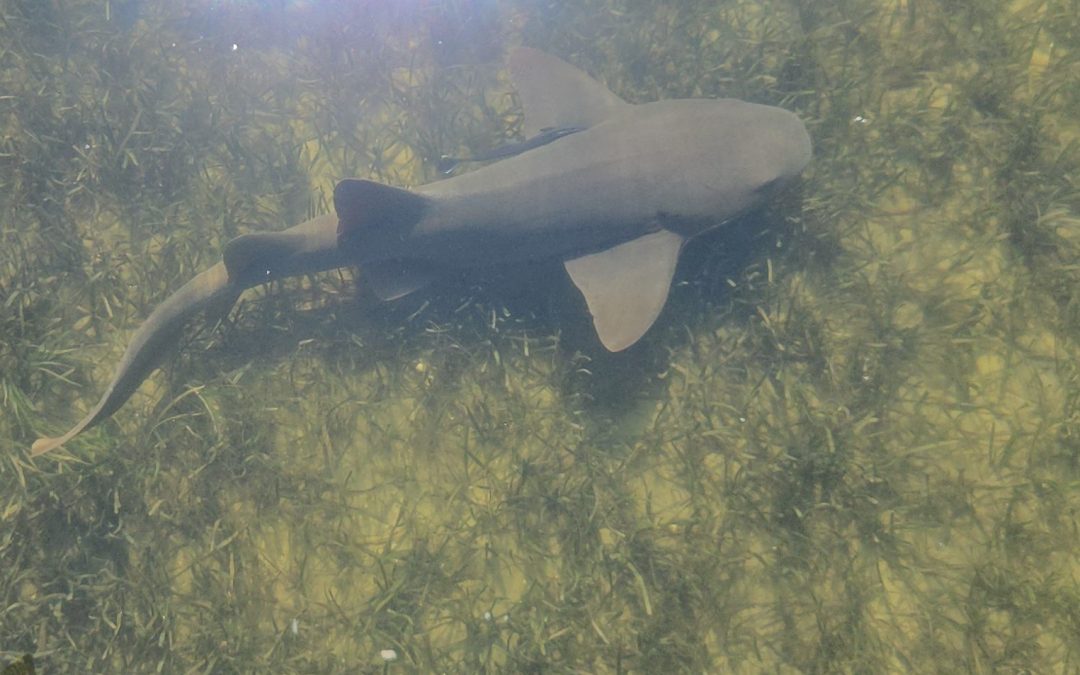
by Rick O'Connor | Oct 21, 2025
Many who have snorkeled or dove in the Florida Keys have most likely encountered nurse sharks there – they are quite common. But here in the northern Gulf – though present – encounters are not as frequent. In the Keys you can don a mask, swim along a seawall, bridge piling, or over limestone bottom in shallow water and found one – maybe several. In the northern Gulf encounters are more offshore by SCUBA alone, and I would say – still not that common.
All this to say that one was seen off a dock recently in Escambia County inside the bay. It was swimming along the edge of the dock in a seagrass bed searching for something to eat. Again, this would not be abnormal if in south Florida, but a cool event in our area.
Nurse sharks are docile fish recognized by their brownish copper coloration, two large dorsal fins set back on their dorsal side, and barbels extending from their upper jaw similar to catfish. These barbels indicate they are more bottom feeders, and they spend a lot of time lying on the bottom. Though they can reach lengths of 14 feet, nurse sharks are not considered a threat – unless you mess with them – and exciting to see.
They are considered a tropical species – hence the lower number of encounters in our area. They prefer hardbottom – such as coral reefs and limestone shelves – higher salinities, dissolved oxygen levels, and clear water. Over this summer local water temperatures have increased, and the lack of rain has increased salinities across the area. The lower amount of rain has reduced stormwater runoff from land and allowed the water to become clearer. Everything that a nurse shark would want.
As mentioned, encounters with this species are not considered threatening and a very cool memory. We do not know how long the current conditions will last but maybe you too will see one. It would be pretty exciting.
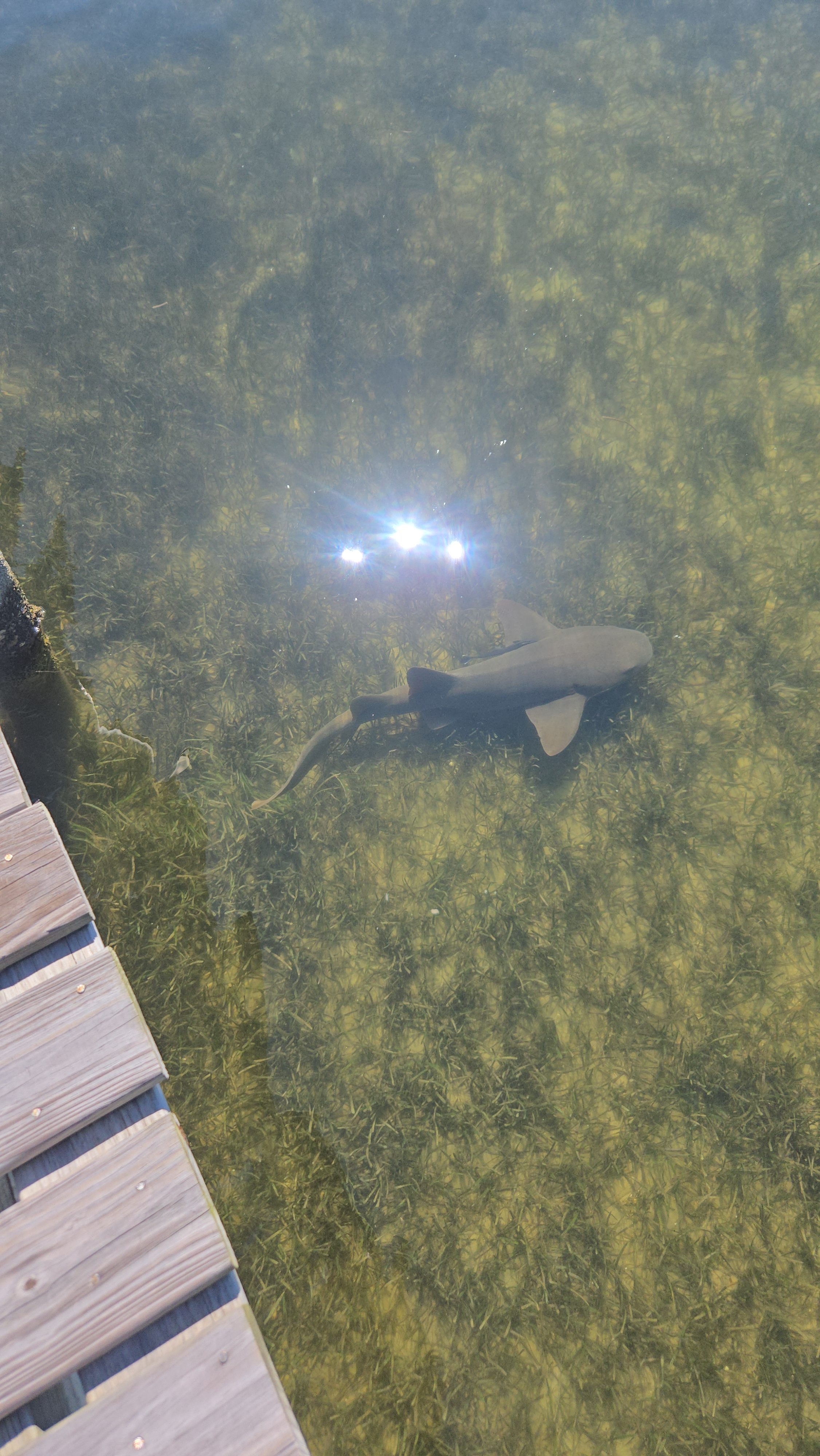
Nurse shark inside bay in Escambia County.
Photo: Angela Guttman









